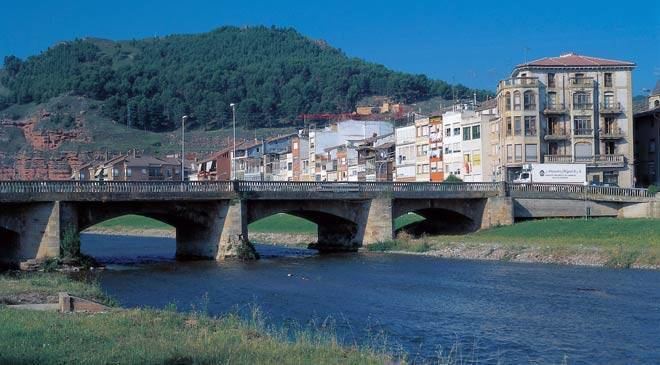Comarca Nájera Time zone CET (UTC+1) Population 8,268 (2014) Province La Rioja | Autonomous community La Rioja Elevation 485 m (1,591 ft) Area 37.44 km² Local time Tuesday 12:59 PM | |
 | ||
Demonym(s) Najerinos or Najerenses Weather 11°C, Wind NW at 18 km/h, 71% Humidity Points of interest Santa María la Real of N, Museo Histórico Arqueolo, El Rincón del Feriante | ||
Nájera ([ˈna.xe.ɾa]) is a small town, former bishopric and now Latin Catholic titular see, former royal capital of Navarra, located in the "Rioja Alta" region of La Rioja, northern Spain, on the river Najerilla. Nájera is a stopping point on the Way of St James.
Contents
- Map of 26300 NC3A1jera La Rioja Spain
- History
- Ecclesiastical History
- Episcopal Ordinaries
- Titular see
- Main sites
- References
Map of 26300 N%C3%A1jera, La Rioja, Spain
History
The area attracted the Romans, who built the town of Tritium on land which now falls within the boundaries of Nájera and the neighbouring municipality of Tricio. Subsequently, the area was under Muslim rule and the name Nájera (Naxara meaning "town between the rocks") is of Arabic origin.
The town was conquered by Ordoño II of Leon for Navarre in 923. Nájera was the capital city of the kingdom of Navarre until it was conquered by Castile in 1054 after the battle of Atapuerca. However, it continued to be multi-cultural. For example, in 1142 the French abbot Peter the Venerable used his visit to Spain to commission translations of important Islamic works, including the first translation of the Qur'an into a European language, and it has been suggested he met with his four translators at Nájera.
From the tenth century, Nájera had a prosperous Jewish community, which was granted relatively favorable legal status after the Christian conquest.
Edward, the Black Prince fought in the Battle of Nájera in 1367, intervening in a Castilian Civil War on behalf of Pedro of Castile.
See also Najara family, a Sephardic Jewish family, originally from Najera.Ecclesiastical History
Established in 923 as Diocese of Nájera, on territory split off from the suppressed Diocese of Calahorra.
Gained territory twice : in 1077 from Diocese of Pamplona and Diocese of Osma, in 1088 from the suppressed Diocese of Álava.
Suppressed itself in 1170, its territory being used to establish the Diocese of Calahorra, to which its last incumbent was appointed.
Episcopal Ordinaries
(all Roman Rite)
Titular see
The diocese was nominally restored in 1969 as Latin Titular bishopric of Naiera (Curiate Italian and Latin; Latin adjective Naiaren(sis) / Nájera (Spanish).
It is vacant, having had the following incumbents, so far of the fitting Episcopal (lowest) rank :
Main sites
The church of Santa María la Real was founded by García Sánchez III of Pamplona in 1052. It is the burial-place of Spanish kings. The monks had to abandon the annexed monastic complex in the 19th century, as a result of the anti-clerical reforms of Juan Álvarez Mendizábal.
Other sites include:
